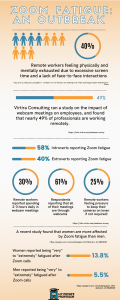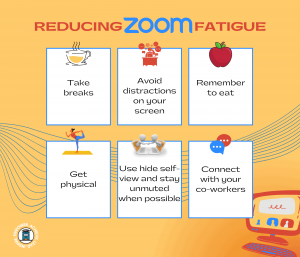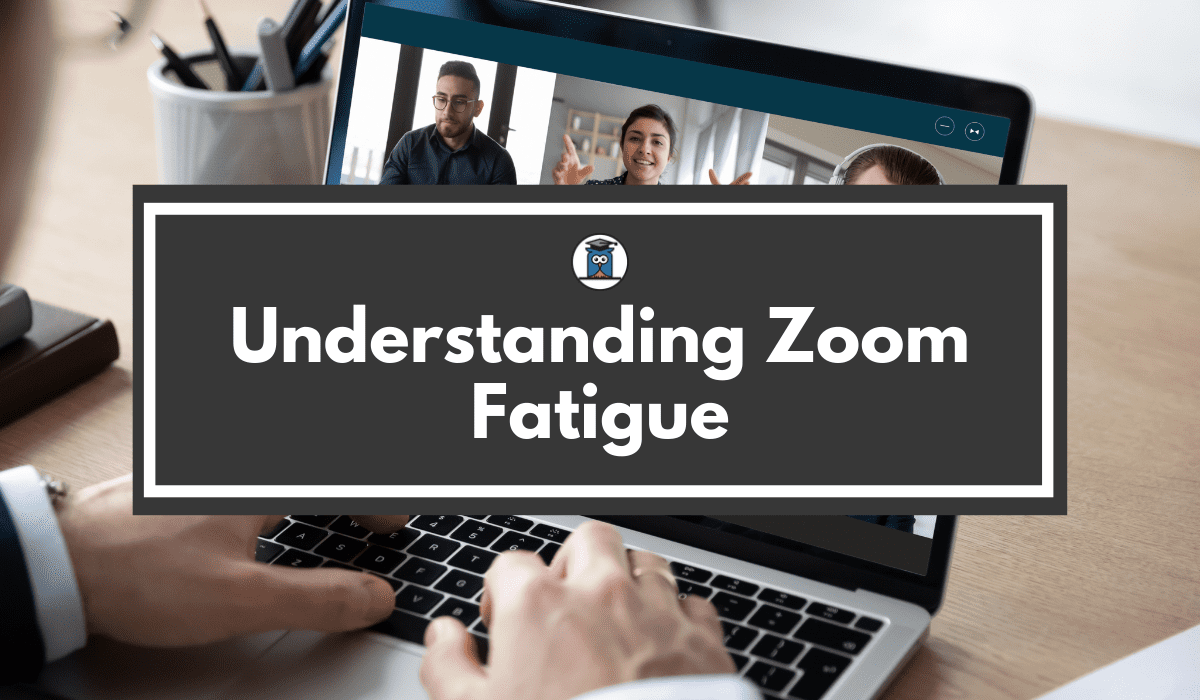Zoom fatigue is real.
While you might be sick and tired of hearing “Zoom”, “virtual”, “remote”, and so on, people are still trying to figure out the whole work-from-home thing. Many people are still struggling to find that perfect work-life balance (whether you’re taking classes or working your full-time job)—myself included!
I’ve noticed that when I sit on the computer for hours on end (which is often a remote-work prerequisite), I get fidgety and distracted. I lose focus, and honestly, I get sore! The back pain after sitting all day is not fun. And I kind of start to feel like a robot.
Understanding Zoom fatigue
If it makes you feel any better about your own Zoom frustrations, most of the people going to Zoom meetings probably don’t just whip through them feeling A-okay. Zoom fatigue is common—too common. And there are several reasons why it makes perfect sense that we’re struggling.
Zoom fatigue causes
So why, exactly, does remote work, and specifically, excessive Zoom time, yield this unique fatigue? After all, you can sit at home for hours in comfy sweats with not a care in the world, so wouldn’t you think this work would be easier?
Close eye gaze
An article and research by Technology, Mind, and Behavior (tmb) uses the elevator example to explain one of the major reasons Zoom may cause discomfort. In an elevator, we often must stand very close to strangers. This “violate[s] a nonverbial norm”—that is, standing extremely close to strangers is not something we often choose to do, and it causes feelings of uneasiness.
When we go on Zoom, we participate in long bouts of “direct eye contact” with faces that are extremely close to our vision. According to the tmb article, in Zoom meetings we are “maintaining an interpersonal distance reserved for loved ones.”
This, unsurprisingly, can deplete us—suddenly, we’ve transitioned to a new (and more exhausting) normal for communicating in the workspace.
Listeners become speakers
Research shows that, when people stare at us while we speak, we experience increased physiological arousal.
In a Zoom meeting, regardless of whether you’re speaking or listening, it’s easy to feel as though all eyes are on you. Also, in an in-person setting, you can know with confidence when someone is staring at you. But with Zoom, it’s a lot more ambiguous—it’s usually impossible to determine where someone is looking. So regardless of whether someone is actually staring at you, you know that people could be–which can hinder focus and induce anxiety.
For some people, the attention may be gratifying. But for many others, it’s unnerving.
In an in-person meeting, it would be unusual for listeners to be the focal point for long periods of time. Usually, one person speaks, the non-speakers listen, and then someone else speaks, and the collective gaze moves. In that traditional setting, listeners aren’t usually the ones in the hot seat. But with Zoom, listeners may often feel as though eyes are on them. 
Monitoring nonverbal cues
In-person interactions majorly include nonverbal communication—and this is largely effortless. On Zoom, we spend more time consciously trying to relay nonverbal messages and at the same time, attempting to decode it from others.
For instance, if you were to rest your gaze naturally in a Zoom meeting, you’d probably look at the faces on the screen. But then you might think to yourself, wait, now I’m not making eye contact. In order to feel like you’re making eye contact with other users, you have to look directly into your camera. And that honestly doesn’t feel natural at all.
We exert energy into expressing nonverbal language in several ways. You may exaggeratedly nod in agreement, use your hands for extra emphasis, or find yourself raising your voice. This is bound to be energy-depleting, since it takes away from the main tasks at hand.
And then when you factor in the extra cognitive load from decoding everyone else’s nonverbal cues, this depletion increases. When thinking about the Zoom structure, you can see how it would be easy to misinterpret nonverbal communication. All users in a meeting don’t have the same grid, so you can’t tell if someone is looking at the speaker or you—or something else on their screen.
All-day mirror
Other than in virtual meetings, you probably don’t spend your days looking at yourself (okay, maybe you do!). Although you can use the “hide self view” feature, the default setting on Zoom is that you see yourself. And even if you use the previously mentioned feature, knowing the option is there—to view yourself and scrutinize your colossal designer eye bags—may be tempting.
A 2010 study demonstrated that when viewing a mirror image of themselves, people are more likely to evaluate themselves. And this isn’t necessarily bad in certain situations. When preparing for a presentation or interview, this can help you feel ready to go. But when you consider actually attending a work meeting, it’s no wonder that we feel fatigued. We’re seemingly trying to balance the work tasks at hand with assessing ourselves (& of course, unloading the nonverbal cues)!
When we are constantly working to juggle paying attention and evaluating ourselves, it can take a toll.
Minimized mobility
When you work in-person, you’re not sitting for long periods of time straight. Many people are sitting in their cubicle—but the difference is that you can move around. Maybe you doodle, make to-do lists, or organize parts of your desk in between tasks. You can get up to get water, use the bathroom, get coffee, etc.
And in meetings, people walk around, stretch, share presentations for which they stand up, use a smart board, etc.
On a Zoom meeting, you may be sitting, staring ahead, and only using your hands on your keyboard. You need to stay seated and in view of the camera, which means that you have limited mobility.
Even on phone calls, you have the option to do minor tasks or make small movements—pacing around, writing notes, doodling, etc. But on Zoom, you’re significantly more immobilized.
How can you combat Zoom fatigue?
Take breaks between Zoom meetings
Research by the Journal of Applied Psychology found that Zoom fatigue is distinct from general workplace fatigue. While work fatigue typically occurs toward the end of the workday, “videoconference fatigue” tends to happen “closer in temporal proximity” to the Zoom meeting.
This suggests that Zoom fatigue is a unique type of exhaustion, and more importantly—what you’re experiencing is real!
If you have a Zoom meeting midday, try to carve a break into your morning to replenish your energy beforehand. 
Get physical
Unfortunately (but not surprisingly), limited mobility can have negative effects on your workday. Research continually demonstrates that movement can positively impact one’s work or academic performance. For instance, a 2014 report found that people who are walking—even indoors—think up more creative ideas than those sitting.
So during your breaks, find some way to be physically active. Have a solo dance party, do some stretching, or simply take a walk around the block.
Prioritize lunch
This research also found that midday Zoom meetings were associated with less fatigue. The reason for this may be that when people eat lunch before a Zoom meeting, they feel more energized and less Zoom-fatigued.
It could also be due to how taking in nutrients causes us to be less fatigued in general (regardless of Zoom meetings)—either way, try to eat (at least a snack) before hopping on Zoom.
Connect with co-workers
Finally, the research indicates that users may feel less fatigued when they feel a higher sense of belonging. When we’re physically disconnected from each other, it’s more challenging to connect through a screen and feel as though we’re on the same page.
Take some time to connect with your co-workers, whether by spending more time chatting, or simply planning a video call for non-work reasons.
Also, the study from the Journal of Applied Psychology discussed how using the “mute” button less, can reduce Zoom fatigue. Using these features may allow the meeting setting to feel more natural—in life, we don’t have a mute button! In a free-flowing, natural conversation, you don’t have to think twice about this type of thing.
Avoid multitasking on Zoom
In general, you get more done when you focus on singular tasks, put them completely to rest, and then turn your attention to other tasks. This is all the more prevalent when it comes to working from home and attending Zoom meetings. Since you’re already putting extra energy into the meetings, doing things on the side will only add to your fatigue.
Essentially, when you multitask, you are putting less energy into each task and thus not completing each to the best of your ability.
Remote work requires a great deal of patience, understanding, and adjustments. And one of the most important things you can do is to learn. Understanding why you may be so fatigued after a day of Zoom meetings can enlighten you and provide you with tools to have a better remote workday. Remote work may not be temporary for you, so it’s in your best interest to put on a brave face and craft better workdays.
Author: Lydia Schapiro






